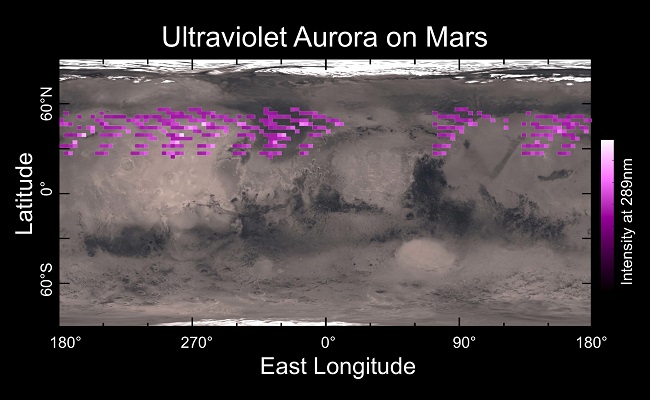Artist's conception of MAVEN's Imaging UltraViolet Spectrograph (IUVS) observing the 'Christmas lights' on Mars. Image via the University of Colorado
Two new ‘unexpected phenomena’ have been discovered by NASA’s Mars Atmosphere and Volatile Evolution (MAVEN) orbiter which appear to show a vast dust cloud and an aurora at its northern pole.
Using the craft’s Langmuir Probe and Waves (LPW) instrument, NASA was able to read that a dust cloud, of unknown exact origin, was found at a height of between 150km and 300km and is not dense enough to pose any risk to the MAVEN craft or other Mars orbiters.
Speculation as to what is causing such a vast cloud has been rampant among NASA scientists, with the most likely suggestions putting the potential causes as originating from Mars’ two moons, Phobos and Deimos; solar wind or debris from an asteroid.
Despite this, NASA is not holding much hope in any of these three suggestions, claiming there is no evidence for such phenomena.

A map of IUVS’s auroral detections in December 2014 overlaid on Mars’ surface. Image via the University of Colorado
Meanwhile, the other expected finding has been described by researchers as Mars’ ‘Christmas lights’ following the recording of an aurora on 25 December last year, similar to the one described as the ‘northern lights’ on Earth.
Lasting for five days, the aurora was most likely created following a huge surge in energetic electrons recorded beamed from the sun and are 100 times more electrically charged than a spark of house current, which gives them greater penetration through Mars’ already-thin atmosphere.
“What’s especially surprising about the aurora we saw is how deep in the atmosphere it occurs – much deeper than at Earth or elsewhere on Mars,” said Arnaud Stiepen, IUVS team member at the University of Colorado. “The electrons producing it must be really energetic.”